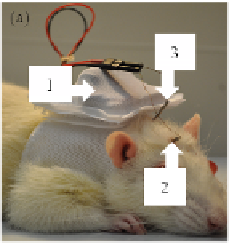Biomedical Engineering Reference
In-Depth Information
The
elec-
tery,
Fig. 6.
Photograph of a rat wit
chronic instrumentation consi
trode, (3) counter-electrode m
(6) DBS stimulator.
h a unipolar electrode that was anesthetized for implantation.
sted of: (1) rat jacket with carrying bag, (2) unipolar Pt/Ir e
made from dental wire, (4) plug connector electrodes, (5) batt
3.3
Impedance Measur
rement
Our data showed the genera
tion process. The measurin
almost doubled after 12 day
days compared to its initial
(Fig. 8b and 9b) decreased.
the monkey brain who desc
reaction as the main reason
study showed that within 3
adhered to the stimulation e
The findings we obtained
that the influence of the po
impedance measurement re
al tendency of an impedance increase during the encapsu
ng results are shown in Fig. 8 and 9. The value of Z´
ys (Fig. 8a) and increased almost 10 times (Fig. 9a) after
value at 10 kHz. In parallel, also the absolute value of
. The results match with findings of Lempka et al. [12]
cribed the formation of the adventitia as a foreign substa
n for the impedance increase. Our own electron-microco
h post implantation, a considerable number of cells firm
electrodes (Fig. 7).
d with the implantation of an array of suture clips indica
osition, shape and material of the counter-electrode on
sults was negligible.
ula-
has
r 22
Z´´
for
ance
opy
mly
ated
the
roscopical images of electrodes that had been implanted and u
ectrode cleaned by trypsination prior to electron microscopy.
tissue.
Fig. 7.
Scanning electron-micr
for 3 h of stimulation. (a): Ele
Electrode with fixed adhering
used
(b):
Our data showed an imp
lowed by a significant incre
ance behavior has already b
no explanation has been giv
pedance decrease at the second day after implantation
ease from the third day on. Interestingly, the same imp
been reported by Lempka et al. [12, p. 6, Fig. 4]. Howev
ven for this phenomenon.
fol-
ped-
ver,





Search WWH ::

Custom Search